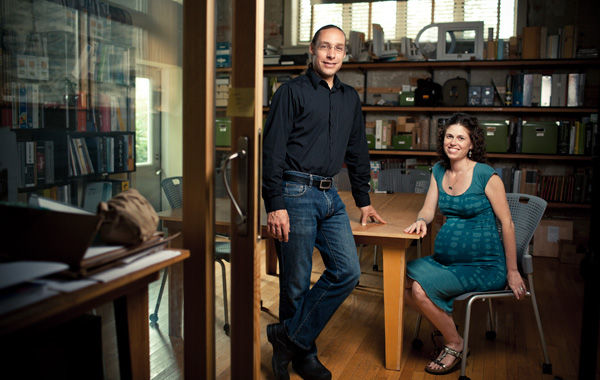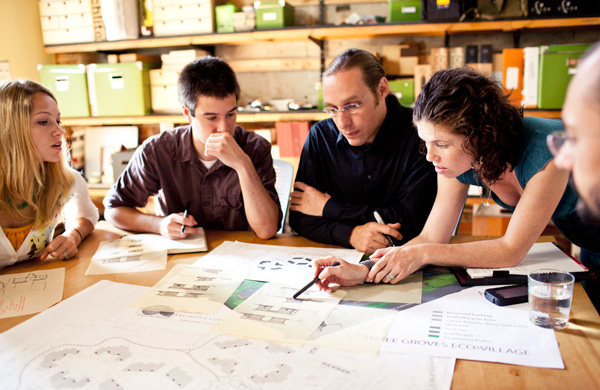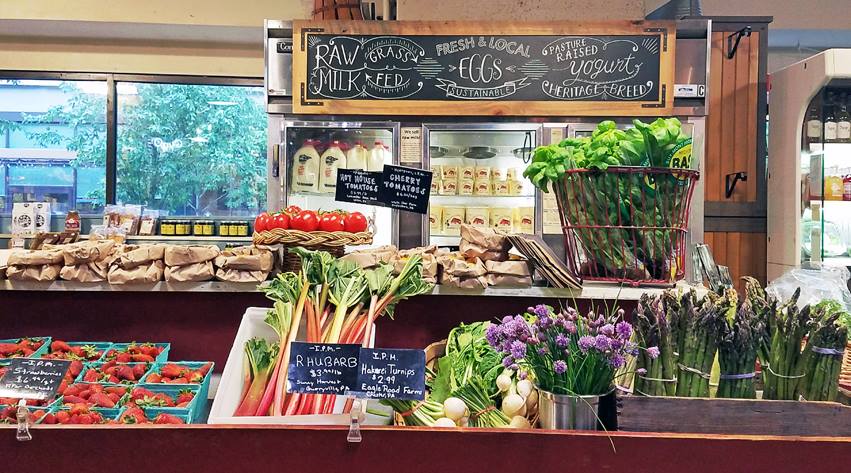 story by g.w. miller iii | photos by gene smirnovScott Kelly, Re:Vision co-founder, steps away from the conference table in the firm’s Manayunk office and explains how they utilized the available light to create a comfortable environment. “There is very little daylight coming in through here,” he says as he stands near the north-facing window. There’s just a faint shadow behind him despite it being midday. The lights are off. “The reason you can see very well in this room is because the light levels are balanced.” He walks away from the window and his faint shadow follows him until he is below one of two narrow, tube-shaped skylights in the ceiling. “The light falls as you step away from the windows,” Kelly says, “but the two small tubes balance the light.”
story by g.w. miller iii | photos by gene smirnovScott Kelly, Re:Vision co-founder, steps away from the conference table in the firm’s Manayunk office and explains how they utilized the available light to create a comfortable environment. “There is very little daylight coming in through here,” he says as he stands near the north-facing window. There’s just a faint shadow behind him despite it being midday. The lights are off. “The reason you can see very well in this room is because the light levels are balanced.” He walks away from the window and his faint shadow follows him until he is below one of two narrow, tube-shaped skylights in the ceiling. “The light falls as you step away from the windows,” Kelly says, “but the two small tubes balance the light.”
It’s dim, he admits, but your eyes easily adjust because the light is even throughout the room. With no lights switched on, no energy is used, and the small skylights allow little solar gain (additional heat from the sun). Even when the lights are on, they seamlessly integrate with the ambient light.
Jenn Rezeli, Re:Vision’s co-founder and Kelly’s wife, says that in green planning, “your building should be doing 90 percent of the work.”
“The architecture does the heavy lifting,” adds Kelly. “The mechanical systems supplement.”
Kelly and Rezeli speak with a passion that draws one into their world of thinking. Their opinions aren’t pushy or condescending; they genuinely want to educate others about having a smaller impact on the natural environment. That’s the mission of their firm, and of their personal lives.
Small Beginnings, Big Success
The couple launched Re:Vision Architecture out of their home in 2001. Since then, the firm has grown to 15 employees and a branch in California. They have designed more than 60 LEED-certified projects (LEED is the standard developed by the United States Green Building Council [USGBC] to measure green building practices). They earned the first and second LEED Platinum certifications, the highest award USGBC gives, in Delaware, and in Pennsylvania, they’ve worked on seven LEED Platinum commercial and eight LEED Platinum home projects. They also helped found the Delaware Valley Green Building Council, which, like Re:Vision, has just reached the 10-year mark.
In 2008, they designed, in collaboration with Roofscapes, Inc., perhaps their best-known project in Philadelphia: a 45,000 square-foot green roof on the PECO building. The roof soaks up roughly 1.5 million gallons of rainwater runoff annually. Other recognized Philadelphia projects include eco-renovations for the White Dog Cafe, the renovation design for the Mariposa Food Co-op and the Fair Food Farmstand at the Reading Terminal Market.
Re:Vision’s staff and projects have received numerous green building and sustainable business awards—most recently a nomination from Bloomberg Businessweek for America’s Most Promising Social Entrepreneur for 2011.
And, of course, they’ve turned their office space, a former stable, into a model of smart, efficient design: radiant heating in the floors, bamboo workstations, skylights throughout the building and open-air flow.
Kelly, 43, the firm’s principal architect, and Rezeli, 38, the managing principal, approach their for-profit operation with a nonprofit mentality. The clients, developers, contractors and code officials on their projects are all involved from the very beginning. And they continue monitoring their buildings long after they’re built. They even educate their clients on how to best use the space by analyzing utility bills.
“We spend a tremendous amount of time helping our clients understand the value—where they get benefits and where they don’t,” says Kelly. “I think that’s really unique about our firm. No one pays for that. It’s still our mission. We’re still going to do it.”
A History of Saving
Rezeli’s enthusiasm for the environment stems from her upbringing in a family with a Depression-era ethos.
“You don’t waste,” she says with a modest laugh. “That was always my motto. You always darn your socks. You turn out the lights.”
After graduating from the University of Notre Dame, she took a job in the nonprofit sector, working on conservation projects and urban planning projects. She led students on energy audits of their schools, daylighting projects and stream-cleaning expeditions.
“I saw the impact on the kids and on the teachers,” Rezeli says, “and how much passion they were bringing to green building projects.”
Kelly’s impetus to start the business came from a cross-country drive he took in 1996. He had visited a small-town café in South Dakota five years prior and loved their soup. On the 1996 trip, he went 400 miles out of his way to return to that café, but it was gone. Most of the businesses surrounding the former restaurant were boarded up as well.
“They built a couple of strip centers outside of town,” Kelly recalls. “It just killed the economy there. I’ll always remember that moment and what a bad design decision was made there. The old town essentially died in a very short time because they wanted the new, suburban, big-box strip mall.”
Originally from Lower Merion, Kelly had been doing historic preservation—finding new uses for old schools and churches—but felt he could be doing more. When he was sitting on the local board of advisors for Earth Force, the nonprofit organization where Rezeli served as national director, the two spoke and hit it off.
“When we met,” Kelly says, “it was kind of the perfect fit.”
In more ways than one—the couple’s second child is due in late October.
A NonProfit Ethos
The firm began small, with only a handful of projects. They often shared their green expertise with other design firms—essentially working with their potential competitors.
“I don’t know how to run a corporation but I know how to run a nonprofit,” Rezeli says. “When you work for a nonprofit, everything is about, ‘Does this fit our mission?’ and ‘How can we have better impact with fewer resources?’ You’re not as concerned about competition as you might be in the corporate world.”
In time their reputation, and business, began to grow.
“We’re still a little firm, a little snowball,” says Rezeli. “We’re not an avalanche of a firm.”
“I don’t think we want to be,” Kelly adds. “We just want to do good, high-quality design work and be green, sustainable and responsible.”
“It’s not about volume of projects as much as impact of projects,” Rezeli continues. “We’re always looking for the right kind of projects.”
Jackie O’Neil approached Re:Vision in 2003. She knew that she wanted to build a pair of sustainable homes in Perkiomenville at market rate, but that’s about all she knew.
“I didn’t even really know what the requirements would be for a green home,” O’Neil remembers. “I just threw out the challenge.”
Kelly and O’Neil sat down, discussed goals and went through building models. Everything was tested, and results discussed. The ultimate design came through collaboration.
“They did a great job of helping me focus on what we could do to build a green home,” O’Neil says.
The results were the first two LEED-homes projects in Pennsylvania. They are zero energy, passive solar structures with radiant heating under concrete floors and a solar panel array that produces 5kW of power.
Rezeli and Kelly debriefed at O’Neil’s home a few weeks after she moved in, further bonding over dinner.
Their working relationship has grown into a friendship, and has spawned more business—Re:Vision is currently partnering with O’Neil on a 37-unit eco-village development in London Grove, Pa.
“Every project is their baby,” says O’Neil of Rezeli and Kelly. “I want to work with people who care about the work and care about the mission.” All About Education
All About Education
“Being a good architect is about listening to the client’s ideas,” says Pierre Noack, the president of Aerzen USA, a Coatesville-based company that manufactures wastewater treatment equipment. “The Re:Vision team not only understood what I was saying, but also the intent.”
Noack included his staff, the HVAC team, crane operators, Philadelphia University students, landscape architects and the Re:Vision crew in the design process, with Rezeli leading the charrette, a collaborative session where designers discuss how to solve a problem. Around 30 to 40 people gathered every day for one week to envision Aerzen’s new, 42,000 square-foot office building and light manufacturing plant.
“It was completely different from a typical building project,” Noack says. “It was a fantastic process.”
The facility features a geothermal heating and cooling system, and straw bales in the walls for insulation.
“That is something we had to do a lot of education with code officials around,” says Rezeli. “We had to have independent testing done on the straw bales.”
The education process at Re:Vision starts with the clients, but goes through the developers, contractors, policy makers, end users and even back to the firm. They are constantly learning.
“It’s so important to have contractors understand what the design intent is,” says Kelly. “But we also have to tell them why it should be important to them.”
He says that he often walks into construction meetings, picks up a tube of caulk and explains why he wants them to use that brand.
“The volatile organic compounds, the VOC, are 25 grams per liter,” he tells the construction crew. “It’s very low. It’s not going to give you cancer like the other stuff.”
Then he hands them the caulk and walks away. He sees the light bulb go on in their heads when they think about their fathers and brothers suffering from cancer.
“All of the sudden, they understand that we’re trying to make them less sick,” Kelly says. “Here are these guys who are not environmentalists, but are now believers because they see the benefit of what we’re trying to do.”
In Philadelphia, Re:Vision championed the waterless urinal system at the Comcast Center. The plumbers union originally opposed a building code change that would allow the waterless system.
“Anytime you’re doing something officials don’t typically see, you’re going to have to do additional education,” Kelly says.
“That’s something we’re usually excited about,” Rezeli adds. “It’s something the client might be excited about, but they’re like, ‘I’m not going to pay you to change this policy.’ But we’ll spend a good amount of time educating the code officials.”
Kelly pauses and notes that in that project they were representing Liberty Property Trust, the developers of the Comcast Center, with whom they have worked on several projects.
“I think on that one,” Rezeli offers, “we were probably volunteering.”
Simply Green
“It’s almost hard to believe how different environmental architecture is now compared to when we started,” Rezeli says. “Literally, people did not know what we were talking about 10 years ago. It was that foreign in Philadelphia. It was that unusual.”
Builders in the U.S. were once environmentally conscious because they had to be, Kelly explains. Then, about 50 years ago, glass became inexpensive. Energy prices dropped. Projects were built that didn’t factor in natural systems for light and heat. Instead, construction began to rely on mechanicals.
“The best architecture uses natural systems to its fullest abilities,” explains Kelly.
It’s that simplicity that Re:Vision employs today—cisterns and rain chains to collect stormwater, proper site alignment, vines serving as living walls, skylights, proper ventilation, water in the walls as insulation.
“Who thinks of this stuff?” asks Scott Seibert, the developer of Bancroft Green, a set of 11 energy-efficient homes in Center City designed by Re:Vision. “I certainly don’t.”
Seibert and his brother are planning another project with Re:Vision in Queen Village.
“They leave their egos at the door,” Seibert says. “Scott? He’s a really big deal, but you’d never know it. He’ll explain every little thing to you, and then roll up his sleeves and get to work.”









Jen Rezelli—Everyone on the street knew you were going to be married to an architect and then be involved in honest to goodness right thinking projects. Not surprised at all. 🙂
Am in NYC with Ari and Zach. Dougie is in Canada on business. Your old friends are healthy and multiplying. My blessings to your belly and whoever happens to be inside it and to your other very lucky child and husband. Ari and Zach both showed me this article separately. Both proud of you.
Was truly great reading about your upbeat life.
Gregg
Jen Rezelli—Everyone on the street knew you were going to be married to an architect and then be involved in honest to goodness right thinking projects. Not surprised at all. 🙂
Am in NYC with Ari and Zach. Dougie is in Canada on business. Your old friends are healthy and multiplying. My blessings to your belly and whoever happens to be inside it and to your other very lucky child and husband. Ari and Zach both showed me this article separately. Both proud of you.
Was truly great reading about your upbeat life.
Gregg